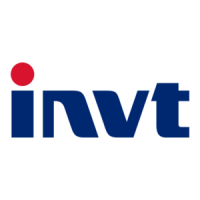How do I resolve encoder EEPROM data check error on INVT Servo Drives?
- PPatricia JacksonSep 12, 2025
If your INVT Servo Drive reports an encoder EEPROM data check error, and the motor uses a communication encoder, it means a data check error occurred when the motor attempted to read data from the encoder EEPROM during power-on. To resolve this: 1. Make sure encoder cables are connected properly and eliminate conditions that disturb encoder communication. 2. Select the motor model based on the setting of P0.00 and execute the operation of writing data to the encoder EEPROM through P4.97 so that data in the encoder EEPROM is updated. 3. Mask this fault by setting P4.98. The motor parameters in the drive EEPROM are used for initialization.




